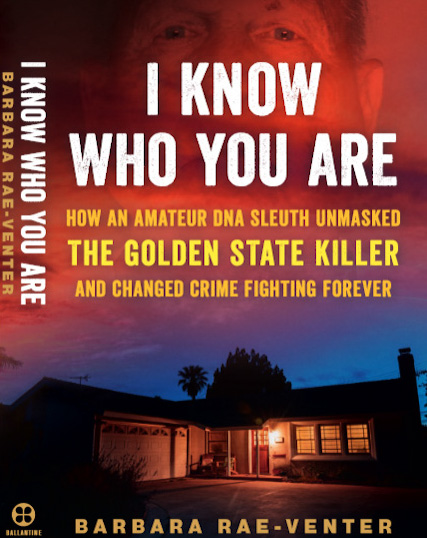Retired patent attorney who helped nab 'Golden State Killer' recounts her remarkable journey

In September 1998, a landscape worker clearing brush near I-85 in Mebane, North Carolina, came upon the skeletal remains of an unidentified child under a towering Howard Johnson’s sign. Despite law enforcement efforts, the youth remained nameless for two decades. He was simply known as “the Boy Under the Billboard.”
Then Barbara Rae-Venter took a shot at solving the case. In just 48 hours, she determined that the boy was Bobby Whitt. Even more remarkable, the retired lawyer cracked the 20-year cold case without leaving her home in Monterey County, California.
By then, the secret to Rae-Venter’s breathtaking work as a gumshoe was widely known. It came out several months earlier, following the April 2018 arrest of “the Golden State Killer,” who terrorized California between 1975 and 1986.
Despite massive law enforcement time and resources—15 agencies, 200,000 personnel hours and $10 million spent—the crime went unsolved for over four decades.
Law enforcement decided to try something different. Knowing of her work with a burgeoning crime-solving technique, they tapped her for help. She and a team of six needed only 63 days and $217 to identify the killer as Joseph DeAngelo.
Their success was in finding clues in direct-to-consumer DNA websites, generally designed for users to trace their family histories. It was the first time that such platforms had served as a crime-solving tool.
DeAngelo pled guilty to 13 counts of first-degree murder and admitted to rapes and other violent crimes that were beyond the reach of the statute of limitations.
For this accomplishment, the 74-year-old native New Zealander earned a place on Time magazine’s 2019 list of the 100 most influential people in America.
“I see this email from Time, and I almost actually deleted it, thinking it was spam, Rae-Venter tells me, chuckling, during a phone interview from her home. “I about fell off my chair when I’m reading it.”
The arrest of the Golden State Killer made worldwide headlines. It would have anyway, given the notoriety of the case. But the bigger story was the unique manner in which it was solved.
It was a watershed moment for law enforcement. But Investigative Genetic Genealogy, as it has come to be known, immediately raised privacy concerns. A 2018 Washington Post headline summed up the sentiment of many: “The Ingenious and ‘Dystopian’ DNA Technique Police Used to Hunt the ‘Golden State Killer’ Suspect.” Three years later, much the same. From Slate magazine: “Your Consumer DNA Test Could Get Your Distant Cousin Convicted of a Crime.”
Rae-Venter shares her work on the case, along with other long-frigid whodunnits she has solved, in her recently published book, I Know Who You Are: How an Amateur DNA Sleuth Unmasked the Golden State Killer and Changed Crime Fighting Forever.
“That was the thought that went through my mind as soon as I realized who he was,” Rae-Venter says.
In a very crowded field of hard-to-distinguish true-crime offerings, Rae-Venter’s title provides a unique and edge-of-your seat insider’s account of the case she calls, accurately so, “a dividing line between the past and the future” for law enforcement. She also takes head-on the enormous ethical debate surrounding this nascent crime solving technique.
 Barbara Rae-Venter.
Barbara Rae-Venter.
From patent lawyer to crime solver
Rae-Venter retired in 2005 after a 20-year career practicing before the United States Patent and Trademark Office—specializing in biotechnology patents.
As a retirement hobby, she set out to use DNA websites, which had recently become available, to try to trace her family history. “My paternal grandmother’s ancestors,” she explains, “had been displaced by the Scottish Clearances, and there was very little in the way of a paper trail to connect the dots from New Zealand back to Nova Scotia where they first settled and back to Scotland.”
That project led to volunteering for an organization that teaches adoptees how to use DNA to locate biological relatives. In 2015, a deputy with the San Bernardino County Sheriff’s Department, who had come to know of Rae-Venter’s work in this area, sought her help.
Could her techniques be used, he wondered, to identify a woman in her mid-30s who had been kidnapped at age 2 and did not know who she was? It could. Thanks to Rae-Venter, the woman was no longer a so-called living Jane Doe.
The former patent practitioner brings the proverbial thinking-like-a-lawyer to the job. “I’m looking at [the cases] in a little bit different way,” she explains. Her legal training enables her to bring a more “rational” approach to her work: “I don’t get caught up as much in the emotion around a lot of these cases. I’m more looking at just the facts. ‘This is the DNA. This is what the DNA is saying. No, we’re not going down that rabbit hole. Yes, this person has a whole string of arrests, but that doesn’t make him a suspect.’”
Additionally, Rae-Venter explains that to make patent applications as broad as possible, she “had to persuade inventors to consider alternate embodiments of their invention. … My questioning mindset—‘Is there some connection here that we’re not seeing?’—turned out to be an asset … in genetic genealogy as well.”
To be sure, Rae-Venter owes a lot of her success to skills learned prior to entering the University of Texas School of Law. With a PhD in biology, she had an earlier career in the medical field, including working as an assistant professor at the University of Texas Medical Branch.
She explains to me, in technical terms, various advantages that her scientific training adds to her genetic genealogy work. But I don’t know much about biology and ask for a more basic explanation.
“When I’m doing stuff, [the science] is always there,” she says. “I’m always thinking about it. I see other people … who don’t necessarily think about the science so much [and] they are trying to look at the most basic ways of connecting people and building [family] trees.”
Essentially, she has a fluency in reading DNA profiles that a lay person may not.
Weighing privacy rights versus solving crimes
Not surprisingly, a tool built for finding long-lost cousins that could now be used to put one behind bars was controversial. It raised all manner of issues concerning the Fourth Amendment’s right against unreasonable searches and seizures. Critics also worried that the technology could go beyond its intended scope and infiltrate all facets of our lives.
Rae-Venter was surprised by the uproar. “Law enforcement should be able to go anywhere the public goes,” she says. “If the technology existed, why should we not use it in pursuit of violent criminals and in identifying their victims?”
It is a “balancing,” she tells me, and “people’s right not to be raped and murdered” outweighs the “right to genetic privacy.”
Besides, she says, it is too late to protect genetic privacy: “People who are related share so much DNA that a common ancestor to them will invariably reveal both persons’ identities, even if one of them has never taken a DNA test.”
Revelation of how the Golden State Killer was caught also brought forth anger from some customers of genetic genealogy websites. They had not been informed that their DNA data could be used by law enforcement.
The rules have now changed. The biggest players in the field, AncestryDNA and 23andMe—while having in their collective possession DNA information on 35 million people—do not allow their information to be used by law enforcement. However, they do advise users that they may be compelled to provide information in response to a subpoena, search warrant or court order. Some much smaller direct-to-consumer DNA databases allow customers to consent to their profiles being used for purposes of criminal investigation. While investigative genetic genealogy has, to date, solved hundreds of previously unsolved cold cases, a “truly staggering number … could likely be solved,” Rae-Venter says, if that motherload of DNA profiles were available to law enforcement.
If that happened, she says, it “would be all my birthdays and Christmases come at once.” These days, Rae-Venter’s work in the area is no longer a hobby. She is director of investigative genetic genealogy at Gene by Gene, the Texas-based parent company of FamilyTreeDNA.
While she is paid for her services—$250 per hour—much of her time is still pro bono on account of offering fee caps for law enforcement: $4,500 per case or $1,500 when retained by the National Center for Missing & Exploited Children.
Cracking long-dormant cases is a source of conflicting emotions for the modern-day crime solver. There are moments of triumph, Rae-Venter says. In addition to giving a name to the boy only known for having been found dead under a billboard, her work also led to his killer. Bobby Whitt’s father, already serving time in federal prison for armed robbery, pled guilty to his son’s murder.
But despite such satisfaction, Rae-Venter says you can’t lose sight of the tragedy at the center of it. “You feel really good that you’ve managed to solve a … cold case and that you’re going to get some justice for [the victim], but it’s a mixed bag.”

Randy Maniloff is an attorney at White and Williams in Philadelphia and an adjunct professor at the Temple University Beasley School of Law. He runs the website CoverageOpinions.info.
This column reflects the opinions of the author and not necessarily the views of the ABA Journal—or the American Bar Association.



